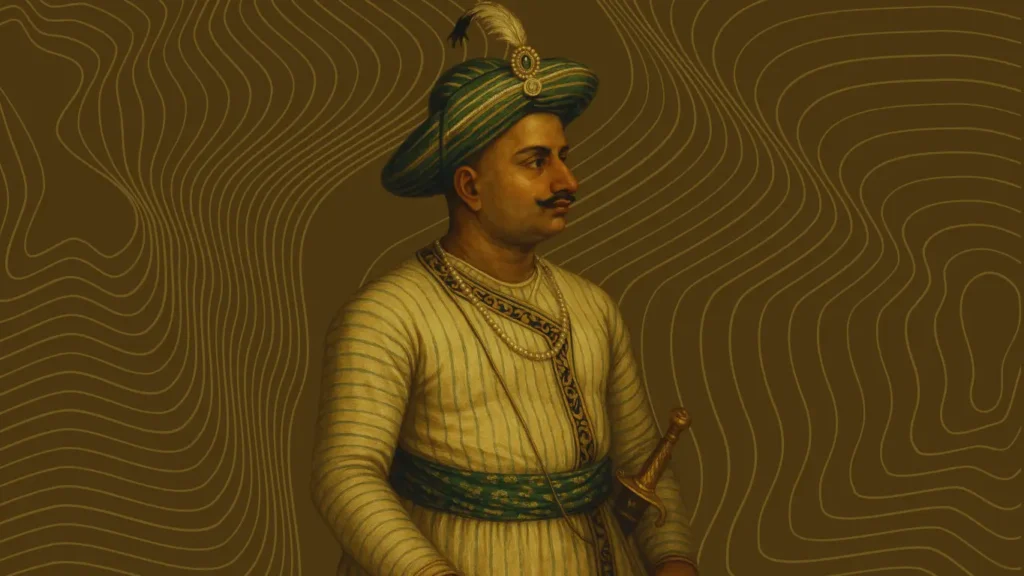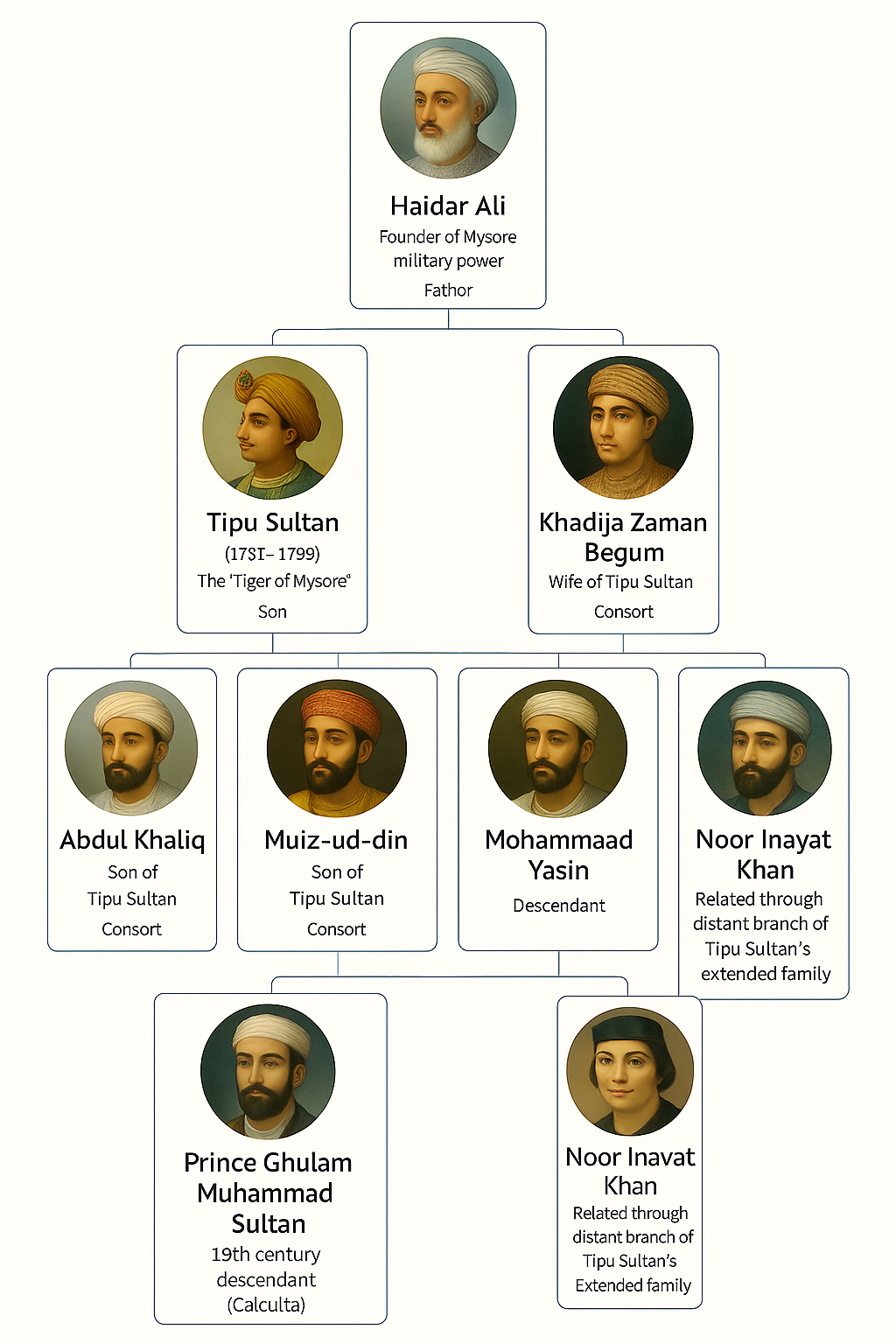
Few rulers in Indian history evoke the same blend of admiration, controversy, and respect as Tipu Sultan. Known as the “Tiger of Mysore,” Tipu was not only a fearless warrior who resisted British colonial expansion but also a visionary who modernized Mysore’s economy and army.
But beyond the wars and politics, an often-overlooked question remains: what became of Tipu Sultan’s family after his death?
This is the story of the Tipu Sultan family tree—a tale of royal lineage, exile, and survival across generations.
Origins: The House of Haidar Ali and the Rise of Tipu Sultan
To understand Tipu Sultan’s ancestry, we must begin with his father, Haidar Ali, the architect of Mysore’s military strength.
Haidar Ali was not born into royalty; he rose through the ranks of the Mysore army through skill, strategy, and leadership. By the mid-18th century, he had established himself as the de facto ruler of Mysore, laying the groundwork for his son’s reign.
Tipu Sultan (1751–1799) inherited both his father’s ambition and his military genius. During his rule from 1782 to 1799, he transformed Mysore into one of the most advanced states in India, pioneering rocketry, coinage reform, and trade networks that rivaled European systems.
However, his defiance of British power made him their greatest adversary—and his family their next target.
2. The Tipu Sultan Family Tree: Bloodline and Descendants
Immediate Family
Father: Haidar Ali
Mother: Fakhr-un-Nissa (also known as Fatima Begum)
Wife: Khadija Zaman Begum (Ruqayya Banu Begum)
Sons:
Abdul Khaliq
Muiz-ud-din
Mohammad Yasin
Mohammad Subhan
When Tipu Sultan was killed in the Battle of Srirangapatna (1799), the British victory ended Mysore’s independence. His death was followed by the forced exile of his wife, sons, and extended family.
The British removed Tipu’s surviving family members from Mysore and imprisoned them at Vellore Fort in Tamil Nadu. They lived there under strict surveillance, separated from their homeland and stripped of their royal privileges.
Exile and Dispersal
Over the next few decades, members of the Tipu Sultan family were relocated to different parts of British India.
Some settled in Kolkata (Calcutta) under British supervision, while others moved to Hyderabad and Bengal.
One of Tipu’s most well-known descendants, Prince Ghulam Muhammad Sultan, lived in Calcutta in the 19th century. Although the British provided him a pension, they carefully monitored his movements and interactions.
3. Descendants Through the Generations
Despite exile, Tipu Sultan’s descendants continued to preserve fragments of their royal identity. Over the generations, the family spread across India, Pakistan, Saudi Arabia, and even the United Kingdom.
Prominent Descendants
Sahibzada Mansoor Ali Tipu Sultan – One of the modern descendants known for maintaining the family’s historical archives in Kolkata.
Noor Inayat Khan – Although not a direct descendant, she belonged to a related branch of the family. Noor became a celebrated British spy during World War II, posthumously awarded the George Cross for her heroism.
Shahzada Anwar Ali – A late 20th-century descendant who played an active role in keeping the memory of Tipu Sultan alive through public heritage programs.
The Tipu Sultan family tree stands as a symbol of survival through displacement and loss, echoing the strength of the ruler who defied empires.
4. The Legacy and Influence of Tipu Sultan’s Lineage
The family of Tipu Sultan represents far more than a royal bloodline—it symbolizes the enduring spirit of resistance against colonial oppression.
Even in exile, many of his descendants valued education, culture, and social reform. The family became an example of how India’s displaced aristocracy adapted to modern life while retaining a sense of historical identity.
According to Britannica, Tipu Sultan’s administrative reforms, his introduction of advanced weaponry, and his diplomatic ties with foreign powers made Mysore one of the most progressive states in 18th-century India.
His descendants, though stripped of their kingdom, continued to embody that spirit of progress and intellectual curiosity.
5. The Mysore Heritage: Cultural and Historical Impact
Tipu Sultan’s lineage is deeply connected to the broader cultural and architectural legacy of Mysore. Many of his contributions—such as the introduction of modern rocketry and economic policies—had lasting effects on South Indian history.
Today, the descendants of Tipu Sultan participate in annual heritage programs and cultural events, particularly in Karnataka.
Artifacts from his court, including letters, coins, and weapons, are displayed in museums across Mysore, London, and Paris, bridging continents through shared history.
The Tipu Sultan family tree remains a link between India’s pre-colonial pride and its post-colonial identity.
6. Controversies and Historical Debates
Like many great historical figures, Tipu Sultan’s life and legacy are subjects of debate.
Colonial-era historians portrayed him as an aggressor, while Indian scholars often depict him as a patriot and reformer.
These conflicting narratives also affect how his family’s story is told. Under British propaganda, his lineage was minimized, their influence curtailed.
Modern research, however, acknowledges Tipu Sultan as one of the first Indian rulers to challenge European dominance through modernization and warfare strategy.
His family’s struggles reflect the human cost of empire—royalty turned into prisoners, visionaries reduced to footnotes, yet surviving through resilience.

7. Modern Relevance: Remembering Tipu’s Family in Today’s India
In the modern context, the Tipu Sultan family tree continues to inspire historians, writers, and filmmakers.
Educational institutions across Karnataka and Kerala include Tipu Sultan’s life and governance in their history curriculum.
His descendants occasionally participate in cultural programs and history conventions, ensuring that their ancestor’s legacy continues to be remembered in both academic and cultural circles.
Tipu’s lineage serves as a bridge between India’s royal past and its democratic present—a reminder of the price of freedom and the endurance of legacy.
Conclusion: The Bloodline That Defied Time
From the thunder of cannons at Srirangapatna to the quiet corridors of Vellore Fort, the Tipu Sultan family tree tells a powerful story of endurance.
Though stripped of their throne and scattered across the subcontinent, Tipu’s descendants preserved their dignity, identity, and heritage.
The Tiger of Mysore may have fallen in 1799, but his legacy—and his bloodline—continues to echo across generations, reminding us that courage and conviction can outlive conquest.
External Reference
FAQs about Tipu Sultan Family Tree
1. Who was Tipu Sultan’s father?
Tipu Sultan’s father was Haidar Ali, the ruler of Mysore who built the foundation for his son’s powerful reign.
2. How many sons did Tipu Sultan have?
Tipu Sultan had four sons: Abdul Khaliq, Muiz-ud-din, Mohammad Yasin, and Mohammad Subhan.
3. Where did Tipu Sultan’s family live after his death?
After Tipu’s death in 1799, the British exiled his family to Vellore Fort in Tamil Nadu.
4. Does Tipu Sultan have any living descendants?
Yes. Several descendants still live in India, particularly in Kolkata, Hyderabad, and parts of Karnataka.
5. What happened to Tipu Sultan’s sons?
His sons were taken into British custody and lived under close supervision for many years.
6. Is Noor Inayat Khan related to Tipu Sultan?
Noor Inayat Khan was a descendant from a related branch of Tipu’s extended family and became a hero during World War II.
7. Why is the Tipu Sultan family tree significant?
It provides valuable insights into how India’s royal families adapted after colonial conquest.
8. Are any Tipu Sultan descendants active in public life today?
A few descendants continue to participate in historical and cultural events related to Mysore’s heritage.
9. What language did Tipu Sultan’s family speak?
They primarily spoke Persian and Urdu, later adopting regional languages like Kannada and Tamil.
10. How is Tipu Sultan remembered today?
Tipu Sultan is remembered as a reformer, strategist, and one of India’s earliest symbols of resistance against colonial rule.
Love exploring the untold chapters of India’s past?
Follow Hypehive for more in-depth stories on forgotten empires, powerful rulers, and the lives that shaped history.
Discover how the past still influences our present—only on Hypehive, where history comes alive.
